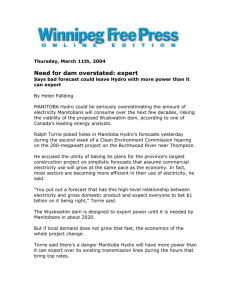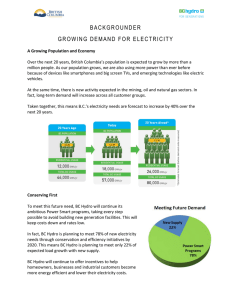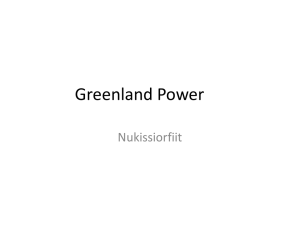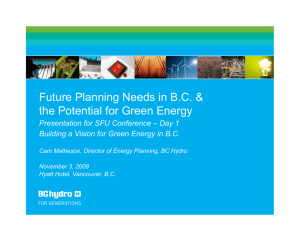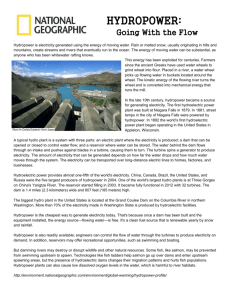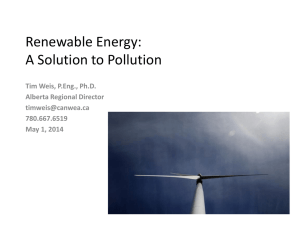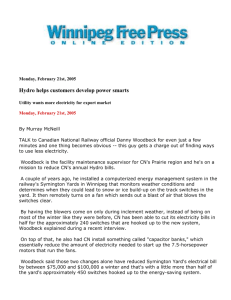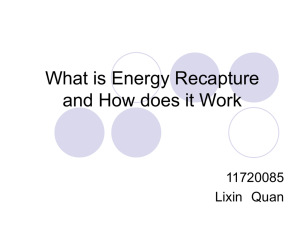Hydro
advertisement
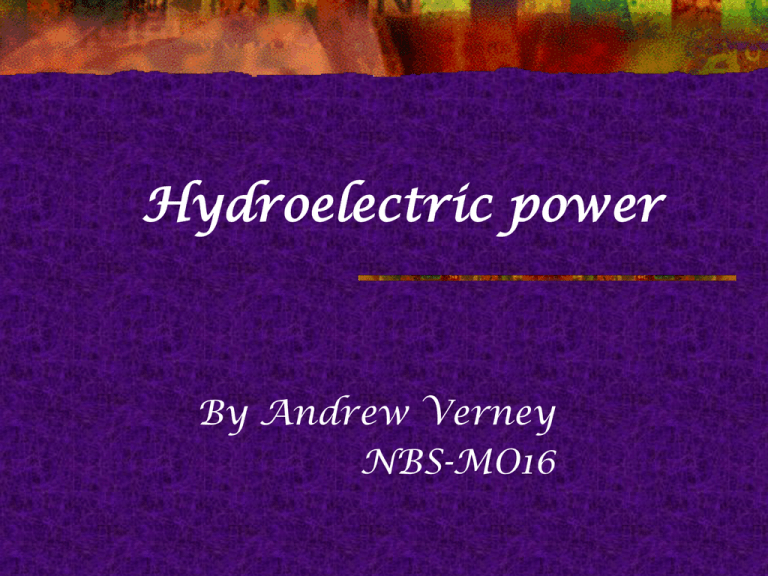
Hydroelectric power By Andrew Verney NBS-MO16 The hydrological cycle t Courtesy Queen Mary University of London Hydro Power Potential 3 Types of Hydro Power Run of River schemes – use the natural flow of the river and there is continuity of flow. Storage – water is stored behind a dam and released through the plant Pumped Storage – the plant can be reversed to pump water uphill when surplus power is available Source: DECC Scales of Hydro Power Pico: <5kW Micro: 5kW – 50kW Small / Mini: 50kW – 20MW Large: >20MW Source: DECC Hydro Power: UKGeneration In 2008, hydro power using natural flows generated approximately: 18.6 PJ of electricity, or 24 % of electricity generated from renewables in the UK Hydro power from pumped storage generated approximately: 19 PJ of electricity, or 1.11 % of all electricity sold in the UK in 2008 http://www.decc.gov.uk/en/content/cms/statistics/source/renewables/renewables.aspx Advantages of Large-Scale HEP Once the dam is built,the energy is very cheap Water ‘energy’ can be stored above the dam Much more reliable than other renewables No waste or pollution produced “Switch off and onable” Reservoirs are multi-purpose amenities – leisure; irrigation; flood control and wetland habitats Constraints of Large-Scale HEP Dams are very expensive Dams cause environmental upheaval upstream and downstream The UK is running out of suitable sites Siltation reduces life expectancy Pumped storage requires available ‘baseline’ power and is not renewable Small Scale Resource and Limitations 675MW of unexploited hydroelectric power in Scotland alone according to recent survey Design life is high, investment cost relatively low Generate electricity for 3p/kWh Short construction times cf Large Scale Requires a suitable watercourse Initial capital cost is significant Environment Agency may not be supportive Multiple ownership of land, fishing and water abstraction rights causes confusion and delay Assumptions – Large Scale Used Declared Net Capacity (DNC) figures from DUKES 2008 Load factor will improve slightly as control management systems improve Changes in rainfall are ignored Glendoe online in 2009 Pumped storage is a management tool not additional capacity 19 99 20 01 20 03 20 05 20 07 20 09 20 11 20 13 20 15 20 17 20 19 20 21 20 23 20 25 20 27 20 29 Estimated Contribution (PJ) Projections – Large scale 20 18 16 14 12 10 8 6 4 2 0 Year Assumptions small scale Government incentives such as feed-in tariffs promote small-scale development Planning and environmental restrictions do not counteract Government incentives Current improved load factors remain at 38% Three Scenarios – Current rate of growth – Doubled rate of growth or halved rate of growth Estimated Contribution (PJ) Projections – Small Scale Current Trend Optimistic Pessimistic 20 18 16 14 12 10 8 6 4 2 0 2004 2009 2014 Year 2019 2024 Conclusions Large Scale development promoted by the Scottish Government could see one or two more large power stations come online. Small scale pant could see a significant increase in percentage terms but remains a small sector.


